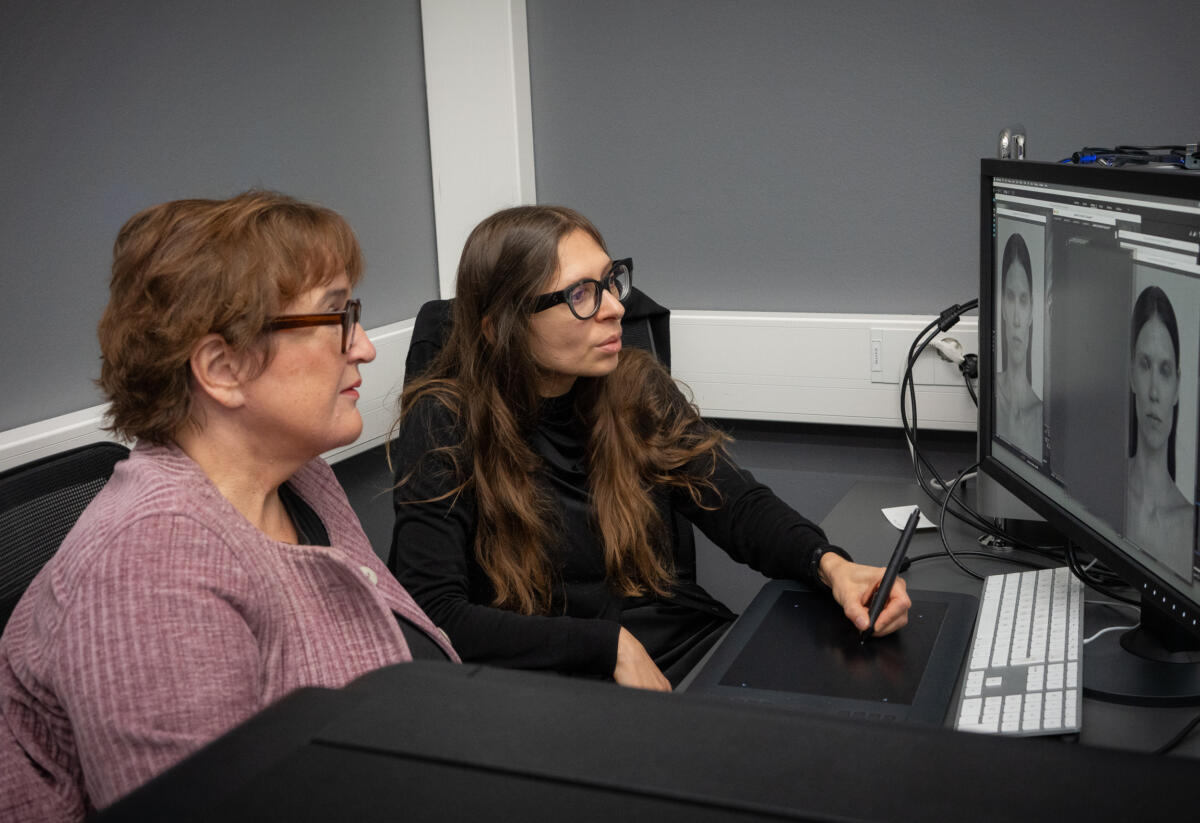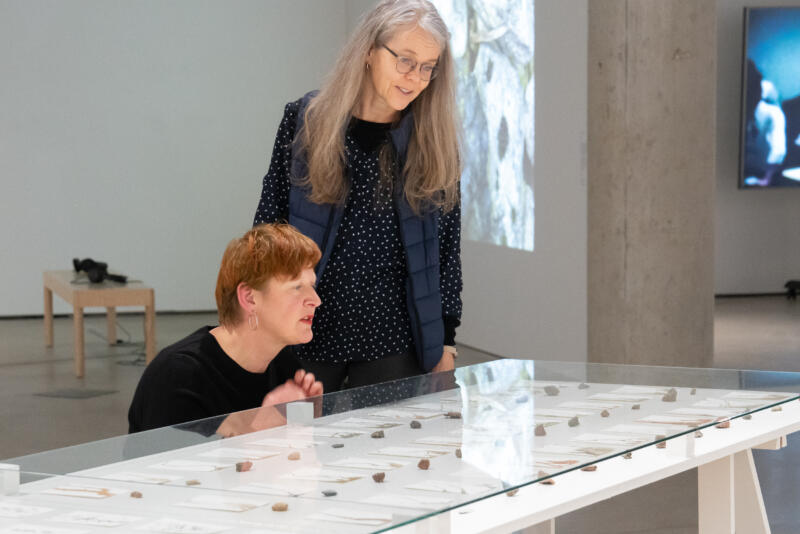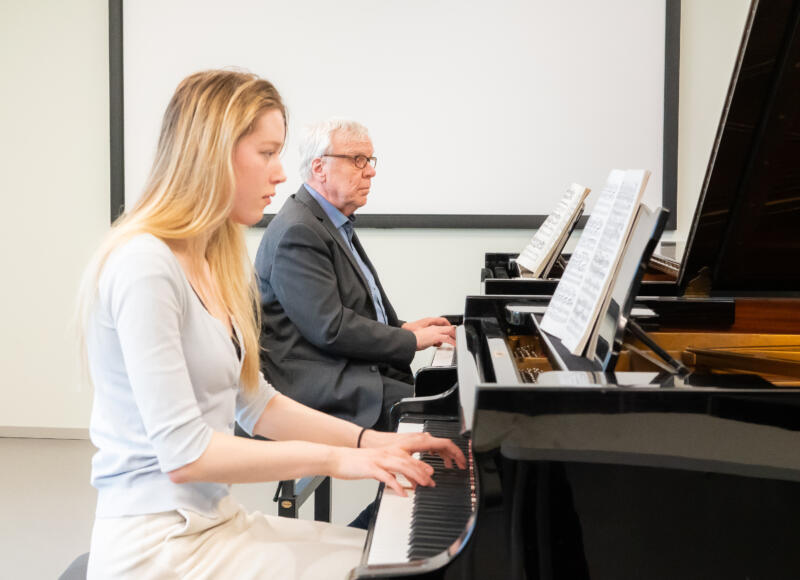Becoming a master: Diana Luganski and Marjaana Kella
In this interview series an art student and teacher discuss their shared learning journey. Diana Luganski is a student at the Academy of Fine Arts, the subject area of time and space. Marjaana Kella is working in the same subject area as a professor.

What do you remember from your first shared lesson?
Diana: I remember Marjaana from my entrance exam interview, which took place during covid. But the first actual lesson together happened during Mylly, which is the orientation period for first-year students at the Academy of Fine Arts. The photography lecture was held in a photography studio, and Marjaana showed e.g. documentary images of Three Standard Stoppages by Marcel Duchamp in the context of photography. What stuck with me from later lectures and meetings was how Marjaana remembered the entrance exam portfolios of a lot of students.
Marjaana: I remember Diana well already from the entrance exam stage, where she demonstrated her competence and profound interest in visual art. The first course of mine that she took was probably The Photographic in Contemporary Art. It’s a thematic theory course exploring the position of photography in contemporary art from various points of view. Because a photograph has such a strong connection to the time and place where the photograph was taken, it’s viewed differently than a painting, for example. A photograph is not viewed only as an image, as we look “through” it at the situation that happened at the time when it was taken. Photographs have a strong presence everywhere in our culture, and because contemporary art is often closely linked to the surrounding reality, photography and moving image are particularly viable media and subjects for contemporary art. Because of this, there are photographic elements in many contemporary art pieces that aren’t photographs per se. On this The Photographic in Contemporary Art course, I took note of how curious and focused Diana was. She really wanted to understand photography as a medium and its role in contemporary art.
What do you think are the most important elements in the interaction between a student and a teacher?
Diana: I believe it’s about the same things that make the interaction good with any two people: respect, trust, interest and the ability to take an interest in another person’s work and way of thinking. And about receiving and giving feedback in an uncomplicated way. I, personally, like direct feedback so you don’t have to later make guesses about what something that was said means. A suggestion about changing something or trying something out is welcome, but often the best feedback from a teacher is in the form of a question. And then when you think about the answer, you get new realisations about your own work. I also find it fairly natural to present wishes about future courses or topics that I’d like to delve into in relation to my own artistic work and that I need in my personal skill set. It’s important to have the courage to verbalise your own thoughts and to ask questions, both as a teacher and a student.
Marjaana: Interaction is built on many things, and it’s different with different students. It’s important to try to feel out the situation and think about what could take the process forward. Sometimes when meeting with a student, ideas are flying around everywhere, and then other times we are completely quiet for a long time and just look at the sketches. The most important thing is to try to understand the premises and goals of the student’s work and try to verbalise what you see when you look at it in its unfinished state. Frequently there may be a big difference between the goal, execution and interpretation, one that the artist hasn’t realised personally. It’s easy for visual artists to become quite blind to their own work. That’s why it’s important to walk along on the path that the student has taken and to also be transparent and straightforward when it’s necessary. If the feedback you give is vague and pointless, it doesn’t give the student the opportunity to challenge the teacher’s views and to develop their work into a completely new and surprising direction. Challenging and doing things differently makes the interaction dynamic and sometimes it may be that the best guidance is when the student is met with a proper opposing force that they can challenge.
Describe your typical study-related meet-up – what happens, what do you usually do?
Diana: I try to participate in as many studio visits as possible with teachers, artists from outside the school and classmates. My main form of expression is lens-based media, especially photography, so I may ask Marjaana for several studio visits during the academic year. We often meet up in the quiet space of the teachers’ room or at PrintLab, which is the room for ink-jet printing and digital and analogue processing of images at the Academy of Fine Arts. Topics vary, and we may talk about concepts and theoretical questions or texts that deal with visual art, and sometimes we go through photos I’ve taken. I often come with a ready-made list of topics and questions that I want to discuss. I try to absorb Marjaana’s and many other teachers’ ability to examine a single image or work for really long – I always think about what it is that they see but I don’t notice.
Marjaana: With Diana, the communication often works simply because of the fact that she has worked with photography for a long time and is aware of what she is doing. I think we understand each other based on pretty small gestures, even nonverbally. When we meet up, Diana talks about her ideas, shows what she is currently working on and then we discuss the works together. As we talk, we may be reminded of various phenomena in or outside the field of art. Sometimes we talk about practical aspects, such as printing or material choices, which aren’t at all such minor details as people sometimes think. The message of an artwork relies just as much on its conceptual goals as on material execution and details. I often try to not to give exhaustive answers and to keep the situation open. I, myself, have an equal opportunity to learn from the situation. It’s interesting sharing thoughts about what kinds of results different choices could lead to and what directions we could see the initial idea for a work taking. I often feel especially envigorated after discussions like these.
What do you think about the role of art in society at the moment?
Diana: Art is the subconscious of our society that should be protected like a child sleeping in peace. Depending on the viewer and the situation, art can be a telescope or a microscope – some sort of a lens through which we can view the world, other people and ourselves in it. I think of art as a suggestion on different perspectives on reality. We often say “close your eyes and imagine”, but I believe art is one of the dimensions where we can safely think, imagine and dream with our eyes open, be in dialogue with worlds.
Marjaana: We often forget that art is implicitly present all around us in our society. Art doesn’t exist merely in the context of art, but it spreads from there everywhere in our culture, often retrospectively. This becomes clear the minute we imagine a world with no art at all, with no literature, visual art, music, films etc… What would it feel like living in a world like that? We would be completely missing the tools to express our innermost experiences and to understand ourselves. What would language be without literature? When people wonder about the provocations in art, they often forget that the provocations are part of the circle of art into which the phenomena of the world around us are reflected and from which they can be seen more clearly. Sometimes the provocations are particularly insightful, but undoubtedly, also the less successful ones are needed to form the circle. Statements that aim to reduce art to a part of the production system forget the most fundamental mission of art.
What is special about your teacher/student as an artist?
Diana: Her extreme precision with details, analytical nature and enormous reserve of knowledge – all these are reflected on her works, texts and teaching. I admire and respect Marjaana’s passion for art and photography and her wish to promote the status of photography as a field in the art scene in Finland and abroad.
Marjaana: Diana has a good amount of both theoretical and practical curiosity. She has a fascinating inner world and her own cultural background, which is reflected on her works. She digs deep into topics but wants to constantly develop herself and acquire new practical skills. She collects many “colours to her palette”, which will definitely be very useful for her as a visual artist. This kind of curious, self-critical and hard-working attitude is absolutely key in a visual artist’s work.
What have you learned from each other?
Diana: I’m learning about a more meditative way of looking at my own works and those of others. It’s good to give the project time so it can settle in its space and in my mind and to later come back and look at it again. Marjaana has also encouraged me to keep going with projects that feel more difficult and uncertain and to ignore trends or the demands set by my surroundings. I’ve learned to ask myself what I want from images or works, and more and more often, I’m able to answer this question.
Marjaana: Diana has a lot of knowledge about culture, visual art and photography also from outside of the sphere of visual art, and it’s always interesting to talk with her and learn from her. It’s been inspiring to watch her work and witness her progress, because during her process, she makes surprising and conceptually ingenious decisions and also knows how to be self-critical. When you forget your own persona and immerse yourself in studying different things, phenomena, tools and materials, the works will take their shape in the flow of all the action. There’s no need for fear! If something doesn’t turn out exactly the way it was supposed to, you can just note that it happened and then move on. This is how Diana works, and it’s been a pleasure to observe it in person.

